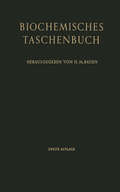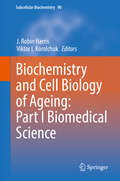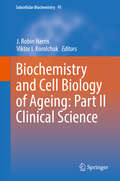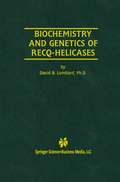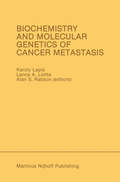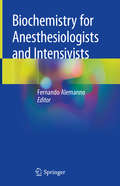- Table View
- List View
Biochemisches Taschenbuch
by Marianne Rauen-BuchkaDem "Taschenbuch für Chemiker und Physiker" ein Taschenbuch für Bio chemiker an die Seite zu stellen, entspricht einem Bedürfnis unserer Zeit. Man kann es zwar nicht in die Tasche seines Rockes stecken, und es wendet sich auch trlcht allein an diejenigen, welche die Biochemie als Lehrfach vertreten oder sich selbst als Biochemiker bezeichnen. Sein Titel wird ungeachtet dessen weithin verständlich sein. Der Hauptwert dieses Taschenbuches liegt meines Erachtens einerseits darin, daß es in Laboratorien, die vorzugsweise biochemische bzw. physiologisch chemische Fragen bearbeiten, am Arbeitstisch zur Hand ist und damit in zahllosen Fällen den Weg in die Bibliothek zu den großen Handbüchern und Nachschlage werken ersparen kann; andererseits darin, daß es auch zu Hause und in Biblio theken, die über keine einschlägigen großen Nachschlagewerke verfügen, eine erste Unterrichtung leicht macht. Möge das vorliegende Werk die chemische Erforschung des Lebendigen fördern und darüber hinaus ein Ratgeber werden für die Vielen, welche im Rahmen unseres Wirtschaftslebens mit Pflanzen, Tieren und Mikroorganismen zu tun haben und deren Produkte weiter verarbeiten. Möge es nicht zuletzt auch seinen Weg in die Kliniken nehmen, den Arzt beraten und damit den Kranken helfen.
Biochemistry
by Raymond S. OchsBiochemistry Second Edition, is a single-semester text designed for undergraduate non-biochemistry majors. Accessible, engaging, and informative, it is the perfect introduction to the subject for students who may approach chemistry with apprehension. Its unique emphasis on metabolism and its kinetic underpinnings gives the text up-to-the-minute relevance for students investigating current public health concerns, such as obesity and diabetes. Biochemistry Second Edition will encourage students to explore the basics of chemistry and its influence on biological problems. Key Features: Provides an understanding of (mostly) enzymatic reactions that are responsible for the function and maintenance of living things. This innovative text for non-biochemistry majors includes introductory material at the beginning of each chapter that contextualizes chapter themes in real-life scenarios. Online supporting materials with further opportunities for research and investigation. Synthesis questions at the end of each chapter that encourage students to make connections between concepts and ideas, as well as develop critical-thinking skills. About the Author: Raymond S. Ochs is a biochemist with a career-long specialty in metabolism spanning 30 years. Previously, he has written the textbook Biochemistry, contributed the metabolism chapters to another text, Principles of Biochemistry, and co-edited a collection of articles published as Metabolic Regulation, and the recent monograph Metabolic Strucure and Regulation. His research interests concern major pathways of liver and muscle, including glycolysis, gluconeogenesis, ureogenesis, fatty acid metabolism, glycogen metabolism, and control by cAMP, Ca2+, diacylglycerol, and AMPK. He is currently professor of pharmacy at St. John’s University in New York, teaching biochemistry, physiology, and medicinal chemistry.
Biochemistry
by Raymond S. OchsBiochemistry Second Edition, is a single-semester text designed for undergraduate non-biochemistry majors. Accessible, engaging, and informative, it is the perfect introduction to the subject for students who may approach chemistry with apprehension. Its unique emphasis on metabolism and its kinetic underpinnings gives the text up-to-the-minute relevance for students investigating current public health concerns, such as obesity and diabetes. Biochemistry Second Edition will encourage students to explore the basics of chemistry and its influence on biological problems. Key Features: Provides an understanding of (mostly) enzymatic reactions that are responsible for the function and maintenance of living things. This innovative text for non-biochemistry majors includes introductory material at the beginning of each chapter that contextualizes chapter themes in real-life scenarios. Online supporting materials with further opportunities for research and investigation. Synthesis questions at the end of each chapter that encourage students to make connections between concepts and ideas, as well as develop critical-thinking skills. About the Author: Raymond S. Ochs is a biochemist with a career-long specialty in metabolism spanning 30 years. Previously, he has written the textbook Biochemistry, contributed the metabolism chapters to another text, Principles of Biochemistry, and co-edited a collection of articles published as Metabolic Regulation, and the recent monograph Metabolic Strucure and Regulation. His research interests concern major pathways of liver and muscle, including glycolysis, gluconeogenesis, ureogenesis, fatty acid metabolism, glycogen metabolism, and control by cAMP, Ca2+, diacylglycerol, and AMPK. He is currently professor of pharmacy at St. John’s University in New York, teaching biochemistry, physiology, and medicinal chemistry.
Biochemistry: An Organic Chemistry Approach
by Michael B. Smith&“There is a continuing demand for up to date organic & bio-organic chemistry undergraduate textbooks. This well planned text builds upon a successful existing work and adds content relevant to biomolecules and biological activity&”. -Professor Philip Page, Emeritus Professor, School of Chemistry University of East Anglia, UK &“Introduces the key concepts of organic chemistry in a succinct and clear way&”. -Andre Cobb, KCL, UK Reactions in biochemistry can be explained by an understanding of fundamental organic chemistry principles and reactions. This paradigm is extended to biochemical principles and to myriad biomolecules. Biochemistry: An Organic Chemistry Approach provides a framework for understanding various topics of biochemistry, including the chemical behavior of biomolecules, enzyme activity, and more. It goes beyond mere memorization. Using several techniques to develop a relational understanding, including homework, this text helps students fully grasp and better correlate the essential organic chemistry concepts with those concepts at the root of biochemistry. The goal is to better understand the fundamental principles of biochemistry. Features: Presents a review chapter of fundamental organic chemistry principles and reactions. Presents and explains the fundamental principles of biochemistry using principles and common reactions of organic chemistry. Discusses enzymes, proteins, fatty acids, lipids, vitamins, hormones, nucleic acids and other biomolecules by comparing and contrasting them with the organic chemistry reactions that constitute the foundation of these classes of biomolecules. Discusses the organic synthesis and reactions of amino acids, carbohydrates, nucleic acids and other biomolecules.
Biochemistry: An Organic Chemistry Approach
by Michael B. Smith&“There is a continuing demand for up to date organic & bio-organic chemistry undergraduate textbooks. This well planned text builds upon a successful existing work and adds content relevant to biomolecules and biological activity&”. -Professor Philip Page, Emeritus Professor, School of Chemistry University of East Anglia, UK &“Introduces the key concepts of organic chemistry in a succinct and clear way&”. -Andre Cobb, KCL, UK Reactions in biochemistry can be explained by an understanding of fundamental organic chemistry principles and reactions. This paradigm is extended to biochemical principles and to myriad biomolecules. Biochemistry: An Organic Chemistry Approach provides a framework for understanding various topics of biochemistry, including the chemical behavior of biomolecules, enzyme activity, and more. It goes beyond mere memorization. Using several techniques to develop a relational understanding, including homework, this text helps students fully grasp and better correlate the essential organic chemistry concepts with those concepts at the root of biochemistry. The goal is to better understand the fundamental principles of biochemistry. Features: Presents a review chapter of fundamental organic chemistry principles and reactions. Presents and explains the fundamental principles of biochemistry using principles and common reactions of organic chemistry. Discusses enzymes, proteins, fatty acids, lipids, vitamins, hormones, nucleic acids and other biomolecules by comparing and contrasting them with the organic chemistry reactions that constitute the foundation of these classes of biomolecules. Discusses the organic synthesis and reactions of amino acids, carbohydrates, nucleic acids and other biomolecules.
Biochemistry and Biology of Coronaviruses (Advances in Experimental Medicine and Biology #142)
by V. Ter MeulenThis book is the result of an international symposium held at the Institute of Virology and Immunobiology of the-University of WUrzburg, Germany, in October 1980. The intent of this symposium was to provide an opportunity to compare the data on coronavirus structure and replica tion as well as to discuss mechanisms of pathogenesis. For over a decade coronaviruses have been recognized as an important group of viruses which are responsible for a variety of diseases of clinical importance in animals and man. Recently new and interesting data on the molecular biology and pathogenesis of coronaviruses have become available and this led us to organize this meeting. The uniformity and diversity in this virus group was evaluated from a molecular point of view and the replication of coronaviruses appears to involve aspects which may be unique for this virus group. Additionally, in contrast to other positive strand RNA viruses it became clear that coronaviruses readily establish persistent infections in the host, a phenomenon which may lead to the different subacute or chronic disorders manifested during coronavirus infection. This volume presents a series of articles based upon the scientific presentation given at the symposium. In addition, there are two articles by B. W. J. Mahy and D. A. J. Tyrrell which summarize the current state of art concerning the biochemistry and biology of coronaviruses, respective ly. We believe this book will be of interest to all virologists and particularly to both established workers and newcomers to this field. V.
Biochemistry and Cell Biology of Ageing: Part I Biomedical Science (Subcellular Biochemistry #90)
by J. Robin Harris Viktor I. KorolchukThis new volume in the Subcellular Biochemistry series will focus on the biochemistry and cellular biology of aging processes in human cells. The chapters will be written by experts in their respective fields and will focus on a number of the current key areas of research in subcellular aging research. Main topics for discussion are mitochondrial aging, protein homeostasis and aging and the genetic processes that are involved in aging. There will also be chapters that are dedicated to the study of the roles of a variety of vitamins and minerals on aging and a number of other external factors (microbiological, ROS, inflammation, nutrition). This book will provide the reader with a state of the art overview of the subcellular aging field. This book will be published in cooperation with a second volume that will discuss the translation of the cell biology of aging to a more clinical setting and it is hoped that the combination of these two volumes will bring a deeper understanding of the links between the cell and the body during aging.
Biochemistry and Cell Biology of Ageing: Part II Clinical Science (Subcellular Biochemistry #91)
by J. Robin Harris Viktor I. KorolchukThis volume of the subcellular Biochemistry series will attempt to bridge the gap between the subcellular events that are related to aging as they were described in the first volume of this set of two books and the reality of aging as this is seen in clinical practice. All chapters will start from the biochemistry or cell biology, where the data is available and work up towards the understanding that we have of aging in the various areas that are related to the subject. Key focus points for this volume are nutrition, external factors and genetics on aging. There will also be chapters that will focus on various organs or tissues in which aging has been well studied, like the eyes, the muscles, the immune system and the bones. The aim of the book project and the book project that is published in concert with this volume is to bring the subcellular and clinical areas into closer contact.
Biochemistry and Cell Biology of Ageing: Part III Biomedical Science (Subcellular Biochemistry #102)
by J. Robin Harris Viktor I. KorolchukThis book provides a state-of-the-art overview of key areas of subcellular aging research in human cells. The reader is introduced to the historical development and progress in biomedical aging research and learns, for example, about the role of microRNAs, circRNAs, mitochondria and extracellular vesicles in cellular senescence. The reader will also learn more about how gap junctions, the nuclear pore complex and the proteasome are affecting the ageing processes. In addition, novel therapeutic opportunities through modulation of cellular senescence are discussed. The book follows on from Parts I and II of Biochemistry and Cell Biology of Ageing (Volumes 90 and 91 of the Subcellular Biochemistry book series) by covering interesting and significant biomedical ageing topics not included in the earlier volumes. Comprehensive and cutting-edge, this book is a valuable resource for experienced researchers and early career scientist alike, who are interested in learning more about the fascinating and challenging question of why and how our cells age.
Biochemistry and Cell Biology of Ageing: Part IV, Clinical Science (Subcellular Biochemistry #103)
by J. Robin Harris Viktor I. KorolchukThis book provides an up-to-date overview of key areas of ageing research and bridges the gap between the subcellular events and the reality of ageing as seen in clinical practice.To this end, the reader learns about the historical development and progression of clinical ageing research. All chapters address the biochemistry or cell biology of various ageing events (to the extent that the data are available) and work their way to the clinical understanding we have of ageing. The focus of this volume is on how dietary restriction, virus infection and chronic inflammation affect the ageing process. Additionally, this book discusses how phosphate metabolism and metabolic dysfunction contribute to ageing events and how various organs and tissues (e.g. tendons, ears, heart muscle, and the endocrine system) age. This book follows on from Parts I, II and III of Biochemistry and Cell Biology of Ageing within the Subcellular Biochemistry book series and aims to bring the subcellular and clinical areas into closer contact by including interesting and significant biomedical ageing topics that were not included in the earlier volumes. Comprehensive and cutting-edge, this book is a valuable resource for experienced researchers and early career scientist alike, who are interested in learning more about the fascinating and challenging question of why and how our cells age.
Biochemistry and Genetics of Recq-Helicases
by David B. LombardBiochemistry And Genetics of RecQ-Helicases provides a background into the role of helicases in general and RecQ helicases specifically in DNA repair. Helicases- enzymes which break down hydrogen bonds between nucleic acid strands in a nucleoside triphosphate-dependent manner-are ubiquitous in biology, participating in processes as diverse as replication, repair, recombination, transcription, and translation. The RecQ-family helicases are a group of helicases which have important roles in the maintenance of genomic stability in many organisms. In humans, mutations in three RecQ-family helicases lead to disease. This book thoroughly examines these helicases. Mutations in the BLM gene lead to Bloom syndrome, a disorder characterized by a susceptibility to many types of cancer. Mutations in the WRN gene cause Werner syndrome, a disease which in some respects resembles premature aging. Finally, mutations in a newly characterized RecQ-family member, RECQ4, may lead to the very rare recessive disorder Rothmund-Thomson syndrome, a condition characterized by developmental abnormalities and some aging-like manifestations. This book is intended for any researchers invested in these particular disorders, or with a general interest in DNA.
Biochemistry and Metabolism
by Anthony J. SbarraThis comprehensive treatise on the reticuloendothelial system is a project jointly shared by individual members of the Reticuloendothelial (RE) Society and bio medical scientists in general who are interested in the intricate system of cells and molecular moieties derived from these cells which constitute the RES. It may now be more fashionable in some quarters to consider these cells as part of what is called the mononuclear phagocytic system or the lymphoreticular system. Nevertheless, because of historical developments and current interest in the subject by investigators from many diverse areas, it seems advantageous to present in one comprehensive treatise current information and knowledge con of the RES, such as morphology, biochemistry, phylogeny cerning basic aspects and ontogeny, physiology, and pharmacology as well as clinical areas including immunopathology, cancer, infectious diseases, allergy, and hypersensitivity. It is anticipated that by presenting information concerning these apparently heterogeneous topics under the unifying umbrella of the RES attention will be focused on the similarities as well as interactions among the cell types constitut ing the RES from the viewpoint of various disciplines. The treatise editors and their editorial board, consisting predominantly of the editors of individual vol umes, are extremely grateful for the enthusiastic cooperation and enormous task undertaken by members of the biomedical community in general and especially by members of the American as well as European and Japanese Reticuloendothe lial Societies.
Biochemistry and Molecular Biology Compendium
by Roger L. LundbladThis book is an accessible resource offering practical information not found in more database-oriented resources. The first chapter lists acronyms with definitions, and a glossary of terms and subjects used in biochemistry, molecular biology, biotechnology, proteomics, genomics, and systems biology. There follows chapters on chemicals employed in biochemistry and molecular biology, complete with properties and structure drawings. Researchers will find this book to be a valuable tool that will save them time, as well as provide essential links to the roots of their science. Key selling features: Contains an extensive list of commonly used acronyms with definitions Offers a highly readable glossary for systems and techniques Provides comprehensive information for the validation of biotechnology assays and manufacturing processes Includes a list of Log P values, water solubility, and molecular weight for selected chemicals Gives a detailed listing of protease inhibitors and cocktails, as well as a list of buffers
Biochemistry and Molecular Biology Compendium
by Roger L. LundbladThis book is an accessible resource offering practical information not found in more database-oriented resources. The first chapter lists acronyms with definitions, and a glossary of terms and subjects used in biochemistry, molecular biology, biotechnology, proteomics, genomics, and systems biology. There follows chapters on chemicals employed in biochemistry and molecular biology, complete with properties and structure drawings. Researchers will find this book to be a valuable tool that will save them time, as well as provide essential links to the roots of their science. Key selling features: Contains an extensive list of commonly used acronyms with definitions Offers a highly readable glossary for systems and techniques Provides comprehensive information for the validation of biotechnology assays and manufacturing processes Includes a list of Log P values, water solubility, and molecular weight for selected chemicals Gives a detailed listing of protease inhibitors and cocktails, as well as a list of buffers
Biochemistry and Molecular Biology of Antimicrobial Drug Action
by T. J. Franklin G. A. SnowThe subject is one of major interest in basic microbiology and infectious diseases and the book is a known classic.
Biochemistry and Molecular Biology of Antimicrobial Drug Action
by Trevor J. Franklin George Alan SnowThe subject is one of major interest in basic microbiology and infectious diseases and the book is a known classic.
Biochemistry and Molecular Biology of Vitamin B6 and PQQ-dependent Proteins
by Ana J. Iriarte Herbert M. Kagan Marino Martinez-CarrionSince the first international meeting on Vitamin B6 involvement in catalysis took place in 1962, there have been periodic meetings every three or four years. In 1990, scientists studying another cofactor, PQQ, which had already attracted the scientific community's interest for its possible involvement in amino acid decarboxylation and reactions involving amino groups, joined forces with those investigating pyridoxal phosphate-dependent enzymes. Since then, the international PQQ/quinoproteins meetings have been held jointly. In the years following the original meeting 37 years ago in Rome, Italy, the scientific gatherings have taken place in Moscow, Russia (1966); Nagoya, Japan (1967); Leningrad (St. Petersburg), Russia (1974); Toronto, Canada (1979); Athens, Greece (1983); Turku, Finland (1987); Osaka, Japan (1990); and Capri, Italy (1996). For the first time in the history of these symposia, the international meeting was held in the United States, from October 31 through November 5, 1999, in Santa Fe, New Mexico. The scientific program focus shifted significantly beyond the original emphasis on catalysis to aspects such as cellular and genetic regulation of events involving proteins that require pyridoxal phosphate or quinoproteins. The growing awareness of the involvement of these proteins in biotechnology processes and fundamental physiological events, as well as their implication in diseases, was also represented, with emphasis on the molecular basis of these events. The meeting was symposium S278, sponsored by the International Union of Biochemistry and Molecular Biology (IUBMB).
Biochemistry and Molecular Genetics of Cancer Metastasis: Proceedings of the Symposium on Biochemistry and Molecular Genetics of Cancer Metastasis Bethesda, Maryland — March 18–20, 1985 (Developments in Oncology #41)
by Alan S. Rabson Lance A. Liotta KarolyLapisThe success rate for treatment of primary neoplasms has improved sig nificantly due to improved surgical, radiotherapy, and chemotherapy methods, and by supportive patient care. In contrast, the treatment of cancer metastases, the cause of most cancer deaths, has not been very successful. Approximately 50% or more of patients with primary malignant neoplasms already have established metastases. Consequently, the most important problem in cancer treatment is the destruction or prevention of metastases. Metastases research has obvious clinical importance. Yet it has only been recently that investigators have attempted to study the mechanisms in volved in this process. This is in part due to the complexity of metastases formation. A metastatic colony is the result of a complicated series of steps involving mUltiple tumor host interactions. It is expected that multiple biochemical factors and gene products derived both from the host and the tumor cell may be required for the metastasizing tumor cell to invade, survive host defenses, travel in the circulation, arrest and adhere in the target organ, invade out, and grow as a metastatic colony. Some of these factors have recently been identified by investigators who have focused on individual steps in the metastatic process and have employed new technologies in immunology, biochemistry and molecular biology. The purpose of this volume is to capture some of the excitement in the field of metastases based on such new discoveries.
Biochemistry and Pharmacology of Platelets (Novartis Foundation Symposia #35)
by Katherine Elliott Julie KnightThe Novartis Foundation Series is a popular collection of the proceedings from Novartis Foundation Symposia, in which groups of leading scientists from a range of topics across biology, chemistry and medicine assembled to present papers and discuss results. The Novartis Foundation, originally known as the Ciba Foundation, is well known to scientists and clinicians around the world.
Biochemistry and Physiology of Visual Pigments: Symposium Held at Institut für Tierphysiologie, Ruhr-Universität Bochum/W. Germany, August 27–30, 1972
by Helmut LangerThis book is a report of a four-day Symposium on the Biochemistry and Physiology of Visual Pigments, which took place immediately after the VIth International Congress on Photobiology, held in Bochum, Federal Republic of Germany, in August 1972. This meeting, which brought together about 50 investigators of various aspects of the visual process, was devoted to the visual cells of both vertebrates and invertebrates. Whereas the International Symposium on the Biochemistry of the Retina, held at Nij megen, The Netherlands, in 1968, had concentrated on vertebrate photoreceptors, this Symposium dealt with invertebrate photoreceptors as well, so that workers in each field could become acquainted with recent progress in the other area. The papers presented at the Symposium were divided into six main topics, to each of which a half-day session was devoted. The six parts of this book, following the intro ductory lecture, essentially correspond to these sessions. In addition to the invited con tributions, the volume contains a number of short communications by other partici pants and two contributions by invited participants, who were unable to attend. The volume closes, as did the Symposium, with a General Discussion, prepared and moderated by S. L. BONTING, in which an attempt was made to integrate various new findings, and to reconcile certain points of disagreement.
Biochemistry Explained: A Practical Guide to Learning Biochemistry
by Thomas MillarBiochemistry Explained employs an innovative approach which has proven highly successful in the author's own classes. The author establishes a thorough understanding of the foundations of and common linkages between molecular structures and reactions, so that eventual interpretation of complex biochemical pathways and reactions is easy. All of the major molecular structures and biochemical pathways are explained, and, for the most part, these center on mammalian biochemistry. The text is supported by biochemical nomenclature and questions to bear in mind while reading. Higher learning sections are also provided for advanced students. Written in an informal, conversational style, this textbook will serve as an invaluable resource for any student who is struggling with the standard texts and for postgraduate students who need to refresh their knowledge.
Biochemistry Explained: A Practical Guide to Learning Biochemistry
by Thomas MillarBiochemistry Explained employs an innovative approach which has proven highly successful in the author's own classes. The author establishes a thorough understanding of the foundations of and common linkages between molecular structures and reactions, so that eventual interpretation of complex biochemical pathways and reactions is easy. All of the major molecular structures and biochemical pathways are explained, and, for the most part, these center on mammalian biochemistry. The text is supported by biochemical nomenclature and questions to bear in mind while reading. Higher learning sections are also provided for advanced students. Written in an informal, conversational style, this textbook will serve as an invaluable resource for any student who is struggling with the standard texts and for postgraduate students who need to refresh their knowledge.
Biochemistry for Anesthesiologists and Intensivists
by Fernando AlemannoThis book discusses and explains the importance of biochemistry knowledge in understanding what happens to patients during anesthesia and/or to those being in intensive care. It covers a wide range of topics, such as Cerebral Edema, Shock, Blood-Brain Barrier, The Pulmonary surfactant, The Acid – Base equilibrium, Local anaesthetics, Perineural adjuvants, Normobaric Oxygen Therapy, Theories of Narcosis. Hyperventilation effects and consequences are also presented. For instance, by hyperventilating a patient with a PaCO2 significantly below 25 mmHg, we risk blocking pyruvic acid carboxylation and transforming it into oxalacetic acid, which in turn knocks out the Krebs cycle, possibly leading to a complication, i.e. to metabolic acidosis and not to compensation for respiratory alkalosis. It is also worth remembering that vitamins are actually molecules of pretty considerable potency and should not be simply intended as integrators. If we inject a patient under intensive care with vitamin C, this not only plays a capillary-protective role but facilitates the conversion of dopamine to noradrenaline. As far as vitamin B6 goes, not only is it the most natural of antiemetics but the coenzyme responsible for transforming glutamate as one of the most powerful excitatory mediators into GABA, one of the fiercest inhibitors. Anesthesiological and intensive care practice require a detailed biochemistry knowledge to avoid onset of complications and/or to deal with unexpected events promptly and appropriately. The book is intended for anesthesiologists, intensivists, anesthesia teachers, anesthesia trainees and residents.
Biochemistry for Health Professionals - E-Book
by Laura Batmanian Simon Worrall Justin RidgeBiochemistry for Health Professionals is a concise introductory text integrating biochemistry with physiology and cell biology and is aimed specifically at introductory health science students. It assumes no prior knowledge and covers some molecular biology and chemistry basics. The text is accompanied by a wealth of resources for both students and instructors via the evolve platform.Written specifically for Health science students with a focus on human biochemistryIntegrated biochemistry with physiological correlationsHighly illustrated with clinical examples to aid understandingOnline teaching and learning resources via Evolve: http://evolve.elsevier.com/AU/Batmanian/biochemistry/
